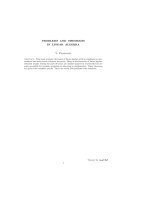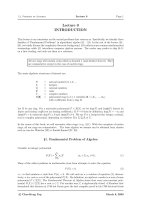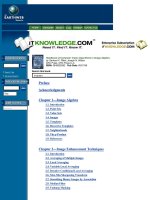Explorations in college algebra 4e
Bạn đang xem bản rút gọn của tài liệu. Xem và tải ngay bản đầy đủ của tài liệu tại đây (16.37 MB, 710 trang )
Kime07_FM.qxd
10/11/07
2:39 PM
Page i
Success in Mathematics
is just a click away…
With WileyPLUS, students and instructors will
experience success in the classroom.
When students succeed in your course—when
they stay on-task and make the breakthrough that
turns confusion into confidence—they are
empowered to realize the possibilities for
greatness that lie within each of them. We know
your goal is to create an environment where
students reach their full potential and experience the exhilaration of
academic success that will last them a lifetime. WileyPLUS can help you
reach that goal.
WileyPLUS is an online suite of resources—including
the complete text—that will help your students:
• come to class better prepared for your lectures
• get immediate feedback and context-sensitive help on assignments
and quizzes
• track their progress throughout the course
“I just wanted to say how much this program helped me
in studying… I was able to actually see my mistakes and
correct them. … I really think that other students should
have the chance to use WileyPLUS.”
Ashlee Krisko, Oakland University
www.wileyplus.com
88%
of students surveyed said it improved
their understanding of the material. *
Kime07_FM.qxd
10/11/07
2:39 PM
Page ii
FOR INSTRUCTORS
WileyPLUS is built around the activities you perform in your class each day. With WileyPLUS you can:
Prepare & Present
Create Assignments
Track Student Progress
Create outstanding class presentations
using a wealth of resources such as
PowerPoint™ slides, image galleries,
interactive simulations, and more.
You can even add materials you have
created yourself.
Automate the assigning and grading
of
homework or quizzes by using the
provided question banks, or by writing
your own.
Keep track of your students' progress
and analyze individual and overall class
results.
Now Available with WebCT and eCollege!
“It has been a great help,
and I believe it has helped
me to achieve a better
grade.”
Michael Morris,
Columbia Basin College
FOR STUDENTS
You have the potential to make a difference!
WileyPLUS is a powerful online system packed with features to help you make the most
of your potential and get the best grade you can!
With WileyPLUS you get:
• A complete online version of your text
and other study resources.
• Problem-solving help, instant grading,
and feedback on your homework and
quizzes.
• The ability to track your progress and
grades throughout the term.
For more information on what WileyPLUS can do to help you and your students reach their potential,
please visit www.wiley.wileyplus.com/experience
74%
of students surveyed said it made
them better prepared for tests. *
*Based upon 7,000 responses to student surveys in academic year 2006-2007
Kime07_FM.qxd
10/11/07
4:20 PM
Page iii
FOURTH EDITION
EXPLORATIONS IN
COLLEGE ALGEBRA
LINDA ALMGREN KIME
JUDITH CLARK
University of Massachusetts, Boston, Retired
B E V E R LY K . M I C H A E L
University of Pittsburgh
in collaboration with
Norma M. Agras Miami Dade College
Robert F. Almgren Courant Institute, New York University
Linda Falstein University of Massachusetts, Boston, Retired
Meg Hickey Massachusetts College of Art
John A. Lutts University of Massachusetts, Boston
Peg Kem McPartland Golden Gate University, Retired
Jeremiah V. Russell University of Massachusetts, Boston; Boston Public Schools
software developed by
Hubert Hohn Massachusetts College of Art
Funded by a National Science Foundation Grant
JOHN WILEY & SONS, INC.
Kime07_FM.qxd
10/11/07
2:39 PM
Page iv
Publisher
Laurie Rosatone
Acquisitions Editor
Jessica Jacobs
Assistant Editor
Michael Shroff
Editorial Assistant
Jeffrey Benson
Marketing Manager
Jaclyn Elkins
Production Manager
Dorothy Sinclair
Senior Production Editor
Sandra Dumas
Design Director
Harry Nolan
Senior Designer
Madelyn Lesure
Senior Media Editor
Stefanie Liebman
Production Management
Publication Services
Bicentennial Logo Design
Richard J. Pacifico
This book was set in 10/12 Times Roman by Publication Services, and printed and bound by
Courier (Westford). The cover was printed by Courier (Westford).
This book is printed on acid-free paper. `
Copyright © 2008 John Wiley & Sons, Inc. All rights reserved.
No part of this publication may be reproduced, stored in a retrieval system or transmitted in any form or by
any means, electronic, mechanical, photocopying, recording, scanning or otherwise, except as permitted
under Section 107 or 108 of the 1976 United States Copyright Act, without either the prior written
permission of the Publisher, or authorization through payment of the appropriate per-copy fee to the
Copyright Clearance Center, Inc., 222 Rosewood Drive, Danvers, MA 01923, website www.copyright.com.
Requests to the Publisher for permission should be addressed to the Permissions Department, John Wiley &
Sons, Inc., 111 River Street, Hoboken, NJ 07030-5774, (201) 748-6011, fax (201) 748-6008, website
/>To order books or for customer service call 1-800-CALL-WILEY(225-5945).
ISBN 978-0471-91688-8
Printed in the United States of America.
10
9
8
7
6
5
4
3
2
1
Kime07_FM.qxd
10/11/07
2:39 PM
Page v
To our students, who inspired us.
Kime07_FM.qxd
10/11/07
2:39 PM
Page vi
A Letter from a Student
My name
is Lexi Fo
urnier and
semester
I am enro
I am a fre
ll
shman he
ed in the A
in College
re at Pitt.
p
p
lied Algeb
Algebra.”
This
ra
B
course us
efore com
courses v
ing “Explo
ing to Pitt,
arying fro
rations
I had take
m algebra
frustration
n numero
to calculu
, stress, an
u
s
s
,
m
a
ll
ath
of which
d a detesta
that I was
produced
tion for m
required to
ath as a su
take a ma
and creati
bject. Wh
th course
ve writing
en I was to
h
e
re
,
m
I
ld
ajor; why
was livid.
by inform
do I need
I am a pre
ing me of
math? My
-law
this new m
non-math
adviser ca
ath class
/science m
lm
a
im
e
d
e
me
ajors the
d at teach
At first I
basic skil
ing
was skep
ls
th
e
y
w
tical, but
ill need in
recomme
I’m writin
everyday
nd this co
g
life.
u
to
r
s
y
e
. What I h
ou now to
been reali
ave learn
emphatic
stic math
e
ally
d thus far
skills pre
confidenc
sented in
in this co
e and mo
u
a
r
“
s
le
e
f
h
ti
t
ave
vation. Fo
brain” me
relatable.
r once in
thod that
The conc
m
fosters
y career a
epts are c
amorphou
s a studen
lear and r
s topics a
t,
e
m
a
li
ath is
s
tic (as op
ddressed
to this cla
posed to
in my ear
ss. I enjoy
th
lier math
e abstract,
doing my
classes).
the lesson
homewor
I
lo
s are appli
o
k
forward
k and pro
cable to m
empower
jects beca
y life and
ed by my
u
s
e
I
feel that
m
y future a
understan
This cour
n
d
d
in
b
g
e
.
c
a
u
se is a vit
se I feel
al additio
my view
n to the m
on the su
ath depar
bject and
call “ever
tment. It
stimulate
yday math
has altere
d
a
n apprecia
.”
d
tion for w
It is my b
hat I like
elief that
to
many stu
and helpf
dents wil
ul as I ha
l find the
ve. Thank
class as e
you for y
ncouragin
our attenti
g
on.
Sincerely
,
Lexi Fou
rnier
Student, U
niversity
of P
ittsburgh
Kime07_FM.qxd
10/11/07
2:39 PM
Page vii
PREFACE
This text was born from a desire to reshape the college algebra course, to make it
relevant and accessible to all of our students. Our goal is to shift the focus from learning
a set of discrete mechanical rules to exploring how algebra is used in the social and
physical sciences. Through connecting mathematics to real-life situations, we hope
students come to appreciate its power and beauty.
Guiding Principles
The following principles guided our work.
• Develop mathematical concepts using real-world data and questions.
• Pose a wide variety of problems designed to promote mathematical reasoning in
different contexts.
• Make connections among the multiple representations of functions.
• Emphasize communication skills, both written and oral.
• Facilitate the use of technology.
• Provide sufficient practice in skill building to enhance problem solving.
Evolution of Explorations in College Algebra
The fourth edition of Explorations is the result of a 15-year long process. Funding
by the National Science Foundation enabled us to develop and publish the first
edition, and to work collaboratively with a nationwide consortium of schools. Faculty
from selected schools in the consortium continued to work with us on the second, third,
and now the fourth editions. During each stage of revision we solicited extensive
feedback from our colleagues, reviewers and students.
Throughout the text, families of functions are used to model real-world phenomena.
After an introductory chapter on data and functions, we first focus on linear and
exponential functions, since these are the two most commonly used mathematical
models. We then discuss logarithmic, power, quadratic, and polynomial functions and
finally turn to ways to extend and combine all the types of functions we’ve studied to
create new functions.
The text adopts a problem-solving approach, where examples and exercises lie on
a continuum from open-ended, nonroutine questions to problems on algebraic skills.
The materials are designed for flexibility of use and offer multiple options for a wide
range of skill levels and departmental needs. The text is currently used in small classes,
laboratory settings, and large lectures, and in both two- and four-year institutions.
vii
Kime07RP1_FM.qxd
viii
4/28/08
5:29 PM
Page viii
PREFACE
Special Features and Supplements
An instructor is free to choose among a number of special features. The Instructor’s
Teaching Manual provides support for using these features and includes sample test
questions. The Instructor’s Solutions Manual contains answers to the even exercises
and even problems in the Chapter Reviews. Both manuals are available free for
adopters either online at www.wiley.com/college/kimeclark or in hardcopy by
contacting your local Wiley representative.
Exploring Mathematical Ideas
Explorations These are open-ended investigations designed to be used in parallel
with the text. They appear at the end of each chapter and in two chapter-length
Extended Explorations.
New! Chapter Review: Putting It All Together Each review contains problems
that apply all of the basic concepts in the chapter. The answers to the odd-numbered
problems are in the back of the text.
Check Your Understanding A set of mostly true/false questions at the end of each
chapter (with answers in the back of the text) offer students a chance to assess their
understanding of that chapter’s mathematical ideas.
?
SOMETHING TO THINK ABOUT
Something to Think About Provocative questions, posed throughout the text, can
be used to generate class discussion or for independent inquiry.
60-Second Summaries Short writing assignments in the exercises and Explorations
ask students to succinctly summarize their findings.
Readings A variety of articles related to topics covered in the text are available on the
course website at www.wiley.com/college/kimeclark.
Using Technology
COURSE
WEBSITE
Technology is not required to teach this course. However, we provide numerous
resources, described below, for teaching with technology that can be downloaded from
the course website at www.wiley.com /college/kimeclark.
Graphing Calculator Manual The manual offers step-by-step instructions for using
the TI83/TI84 family of calculators that are coordinated with the chapters in the text. It is
free on the course website or at a discount when packaged in hardcopy with the text.
Interactive Software for Mac and PC Programs for visualizing mathematical
concepts, simulations, and practice in skill building are available on the course website.
They may be used in classroom demonstrations or a computer lab, or downloaded for
student use at home.
DATA
Excel and TI83/TI84 Graph Link Files Data files containing all the major data sets
used in the text are available on the course website.
Practice in Skill Building
Algebra Aerobics These collections of skill-building practice problems are
integrated throughout each chapter. Answers for all Algebra Aerobics problems are
in the back of the text.
WileyPLUS This is a powerful online tool that provides a completely integrated suite
of teaching and learning resources in one easy-to-use website. It offers an online
assessment system with full gradebook capabilities, which contains algorithmically
generated skill-building questions from the Algebra Aerobics problems and the exercises
in each chapter. Faculty can view the online demo at www.wiley.com/college/wileyplus.
Kime07_FM.qxd
10/11/07
2:39 PM
Page ix
Acknowledgments
ix
The Fourth Edition
Overall Changes
Extensive faculty reviews guided our work on the fourth edition. The sequence of the
chapters remains the same as in the third edition, but we have included
• New chapter reviews, called “Putting It All Together,” with problems that bring
together the major concepts of the chapter.
• A relocation of exercises from the end of the chapter to the end of each section.
• Expanded coverage of several topics, including function notation, range and domain,
piecewise linear functions (including absolute value and step functions), rational
functions, composition, and inverse functions.
• Extensive updates of the data sets.
• Revisions to many chapters for greater clarity.
• Many new problems and exercises, ranging from basic algebraic manipulations to
real-world applications.
Detailed Changes
CHAPTER REVIEWS: “PUTTING IT ALL TOGETHER” appear at the end of each chapter.
CHAPTER 1: Making Sense of Data and Functions has a new section on the
language of functions, with expanded coverage of function notation, domain, and
range. Boxes have been added to highlight important concepts.
CHAPTER 2: Rates of Change and Linear Functions has a new subsection on
piecewise linear functions, including the absolute value function and step functions.
EXTENDED EXPLORATION: Looking for Links between Education and
Earnings uses an updated data set from the U.S. Census about 1000 individuals.
CHAPTER 5: Growth and Decay: An Introduction to Exponential Functions
has an expanded discussion on constructing an exponential function given its doubling
time or half-life.
CHAPTER 7: Power Functions has an added discussion of asymptotes for negative
integer power functions.
CHAPTER 8: Quadratics, Polynomials, and Beyond has changed the most. The
old Section 8.6 has been expanded and broken up into three sections. Section 8.6, “New
Functions from Old,” discusses the effect of stretching, compressing, shifting,
reflecting, or rotating a function. Section 8.7, “Combining Two Functions,” includes
the algebra of functions and an expanded subsection on rational functions. Section 8.8,
“Composition and Inverse Functions,” extends the coverage of these topics.
Acknowledgments
We wish to express our appreciation to all those who helped and supported us during
this extensive collaborative endeavor. We are grateful for the support of the National
Science Foundation, whose funding made this project possible, and for the generous
help of our program officers then, Elizabeth Teles and Marjorie Enneking. Our original
Advisory Board, especially Deborah Hughes Hallett and Philip Morrison, and our
original editor, Ruth Baruth provided invaluable advice and encouragement.
Over the last 15 years, through five printings (including a rough draft and
preliminary edition), we worked with more faculty, students, TAs, staff, and
administrators than we can possibly list here. We are deeply grateful for supportive
colleagues at our own University. The generous and ongoing support we received from
Theresa Mortimer, Patricia Davidson, Mark Pawlak, Maura Mast, Dick Cluster,
Anthony Beckwith, Bob Seeley, Randy Albelda, Art MacEwan, Rachel Skvirsky, Brian
Butler, among many others, helped to make this a successful project.
Kime07_FM.qxd
x
10/11/07
2:39 PM
Page x
PREFACE
We are deeply indebted to Ann Ostberg and Rebecca Hubiak for their dedicated
search for mathematical errors in the text and solutions, and finding (we hope) all of
them. A text designed around the application of real-world data would have been
impossible without the time-consuming and exacting research done by Patrick Jarrett,
Justin Gross, and Jie Chen. Edmond Tomastik and Karl Schaffer were gracious enough
to let us adapt some of their real-world examples in the text.
One of the joys of this project has been working with so many dedicated faculty
who are searching for new ways to reach out to students. These faculty, and their
teaching assistants and students all offered incredible support, encouragement, and a
wealth of helpful suggestions. In particular, our heartfelt thanks to members of our
original consortium: Sandi Athanassiou and all the wonderful TAs at University of
Missouri, Columbia; Natalie Leone, University of Pittsburgh; Peggy Tibbs and John
Watson, Arkansas Technical University; Josie Hamer, Robert Hoburg, and Bruce King,
past and present faculty at Western Connecticut State University; Judy Stubblefield,
Garden City Community College; Lida McDowell, Jan Davis, and Jeff Stuart, University
of Southern Mississippi; Ann Steen, Santa Fe Community College; Leah Griffith, Rio
Hondo College; Mark Mills, Central College; Tina Bond, Pensacola Junior College;
and Curtis Card, Black Hills State University.
The following reviewers’ thoughtful comments helped shape the fourth edition:
Mark Gïnn, Appalachian State; Ernie Solheid, California State University, Fullerton;
Pavlov Rameau, Florida International University; Karen Becker, Fort Lewis College;
David Phillips, Georgia State University; Richard M. Aron and Beverly Reed, Kent
State University; Nancy R. Johnson, Manatee Community College; Lauren Fern,
University of Montana; Warren Bernard, Linda Green, and Laura Younts, Santa Fe
Community College; Sarah Clifton, Southeastern Louisiana University; and Jonathan
Prewett, University of Wyoming.
We are especially indebted to Laurie Rosatone at Wiley, whose gracious oversight
helped to keep this project on track. Particular thanks goes to our new editors Jessica
Jacobs, Acquisitions Editor; John-Paul Ramin, Developmental Editor; Michael Shroff,
Assistant Editor; and their invaluable assistant Jeffrey Benson. It has been a great pleasure,
both professionally and personally, to work with Maddy Lesure on her creative cover design
and layout of the text. “Explorations” and the accompanying media would never have been
produced without the experienced help from Sandra Dumas, Dorothy Sinclair, and Stefanie
Liebman. Kudos to Jan Fisher at Publication Services. Throughout the production of this
text, her cheerful attitude and professional skills made her a joy to work with. Over the
years many others at Wiley have been extraordinarily helpful in dealing with the myriad of
endless details in producing a mathematics textbook. Our thanks to all of them.
Our families couldn’t help but become caught up in this time-consuming endeavor.
Linda’s husband, Milford, and her son Kristian were invaluable scientific and, more
importantly, emotional resources. They offered unending encouragement and sympathetic shoulders. Judy’s husband, Gerry, become our Consortium lawyer, and her
daughters, Rachel, Caroline, and Kristin provided support, understanding, laughter,
editorial help and whatever was needed. Beverly’s husband, Dan, was patient and
understanding about the amount of time this edition took. Her daughters Bridget and
Megan would call from college to cheer her on and make sure she was not getting too
stressed! All our family members ran errands, cooked meals, listened to our concerns,
and gave us the time and space to work on the text. Our love and thanks.
Finally, we wish to thank all of our students. It is for them that this book was written.
Linda, Judy, and Bev
P.S. We’ve tried hard to write an error-free text, but we know that’s impossible.
You can alert us to any errors by sending an email to Be sure
to reference Explorations in College Algebra. We would very much appreciate
your input.
Kime07_FM.qxd
10/11/07
2:39 PM
Page xi
COVERING THE CONTENTS
The following flow chart suggests some alternative paths through the chapters that have
worked successfully for others.
Ch. 1: Making Sense of
Data and Functions
Ch. 2: Rates of Change
and Linear Functions
Extended Exploration:
Looking for Links between
Education and Earnings
Ch. 3: When Lines Meet:
Linear Systems
Ch. 4: The Laws of
Exponents and Logarithms:
Measuring the Universe
Ch. 5: Growth and Decay:
An Introduction to
Exponential Functions
Ch. 6: Logarithmic Links:
Logarithmic and
Exponential Functions
Ch. 7: Power Functions
Ch. 8: Quadratics,
Polynomials, and Beyond
Extended Exploration: The
Mathematics of Motion
The straight vertical path through Chapters 1, 2, 4, 5, and 8, covering linear,
exponential, quadratic and other polynomial functions, indicates the core content of the
text. You may choose to cover these chapters in depth, spending time on the
explorations, readings and student discussions, writing, and presentations. Or you may
pick up the pace and include as many of the other chapters and Extended Explorations
as is appropriate for your department’s needs.
xi
Kime07_FM.qxd
10/11/07
2:39 PM
Page xii
Kime07_FM.qxd
10/11/07
2:39 PM
Page xiii
TABLE OF CONTENTS
CHAPTER 1
MAKING SENSE OF
DATA AND FUNCTIONS
1.1 Describing Single-Variable Data
2
Visualizing Single-Variable Data 2
Mean and Median: What is “Average” Anyway?
An Introduction to Algebra Aerobics 7
6
1.2 Describing Relationships between Two Variables
Visualizing Two-Variable Data 13
Constructing a “60-Second Summary”
Using Equations to Describe Change
13
14
16
1.3 An Introduction to Functions
22
What is a Function? 22
Representing Functions in Multiple Ways 23
Independent and Dependent Variables 24
When is a Relationship Not a Function? 24
1.4 The Language of Functions
Function Notation
Domain and Range
29
29
33
1.5 Visualizing Functions
39
Is There a Maximum or Minimum Value? 39
Is the Function Increasing or Decreasing? 40
Is the Graph Concave Up or Concave Down?
Getting the Big Idea 42
CHAPTER SUMMARY
40
49
C H E C K Y O U R U N D E R S TA N D I N G
50
C H A P T E R 1 R E V I E W: P U T T I N G I T A L L T O G E T H E R
52
E X P L O R AT I O N 1 . 1 Collecting, Representing, and Analyzing Data
E X P L O R AT I O N 1 . 2 Picturing Functions
61
E X P L O R AT I O N 1 . 3 Deducing Formulas to Describe Data
CHAPTER 2
RATES OF CHANGE AND 2.1 Average Rates of Change 66
Describing Change in the U.S. Population over Time
LINEAR FUNCTIONS
Defining the Average Rate of Change 67
Limitations of the Average Rate of Change
66
68
2.2 Change in the Average Rate of Change
71
2.3 The Average Rate of Change is a Slope
76
Calculating Slopes
76
xiii
63
58
Kime07_FM.qxd
10/11/07
xiv
2:39 PM
Page xiv
TABLE OF CONTENTS
2.4 Putting a Slant on Data
82
Slanting the Slope: Choosing Different End Points
Slanting the Data with Words and Graphs 83
82
2.5 Linear Functions: When Rates of Change Are Constant
What If the U.S. Population Had Grown at a Constant Rate?
Real Examples of a Constant Rate of Change 87
The General Equation for a Linear Function 90
2.6 Visualizing Linear Functions
The Effect of b
The Effect of m
87
94
94
94
2.7 Finding Graphs and Equations of Linear Functions
99
Finding the Graph 99
Finding the Equation 100
2.8 Special Cases
108
Direct Proportionality 108
Horizontal and Vertical Lines 110
Parallel and Perpendicular Lines 112
Piecewise Linear Functions 114
The absolute value function 115
Step functions 117
2.9 Constructing Linear Models for Data
122
Fitting a Line to Data: The Kalama Study 123
Reinitializing the Independent Variable 125
Interpolation and Extrapolation: Making Predictions
CHAPTER SUMMARY
126
131
C H E C K Y O U R U N D E R S TA N D I N G
132
C H A P T E R 2 R E V I E W: P U T T I N G I T A L L T O G E T H E R
E X P L O R AT I O N 2 . 1 Having It Your Way
134
139
E X P L O R AT I O N 2 . 2 A Looking at Lines with the Course Software
E X P L O R AT I O N 2 . 2 B Looking at Lines with a Graphing Calculator
AN EXTENDED
EXPLORATION:
LOOKING FOR
LINKS BETWEEN
EDUCATION AND
EARNINGS
Using U.S. Census Data
148
Is There a Relationship between Education and Earnings?
Regression Lines: How Good a Fit? 151
148
Interpreting Regression Lines: Correlation vs. Causation
154
Do Earnings Depend on Age? 155
Do Earnings Depend upon Gender?
How Good are the Data? 157
How Good is the Analysis? 157
EXPLORING ON YOUR OWN
EXERCISES
159
142
146
Summarizing the Data: Regression Lines
Raising More Questions
141
155
157
153
87
Kime07_FM.qxd
10/11/07
2:39 PM
Page xv
Table of Contents
CHAPTER 3
WHEN LINES MEET:
LINEAR SYSTEMS
3.1 Systems of Linear Equations
166
An Economic Comparison of Solar vs. Conventional Heating Systems
3.2 Finding Solutions to Systems of Linear Equations
Visualizing Solutions 171
Strategies for Finding Solutions 172
Linear Systems in Economics: Supply and Demand
171
176
3.3 Reading between the Lines: Linear Inequalities
Above and Below the Line 183
Manipulating Inequalities 184
Reading between the Lines 185
Breakeven Points: Regions of Profit or Loss
166
183
187
3.4 Systems with Piecewise Linear Functions: Tax Plans
193
Graduated vs. Flat Income Tax 193
Comparing the Two Tax Models 195
The Case of Massachusetts 196
CHAPTER SUMMARY
201
C H E C K Y O U R U N D E R S TA N D I N G
202
C H A P T E R 3 R E V I E W: P U T T I N G I T A L L T O G E T H E R
204
E X P L O R AT I O N 3 . 1 Flat vs. Graduated Income Tax: Who Benefits?
209
CHAPTER 4
THE LAWS OF
EXPONENTS AND
LOGARITHMS:
MEASURING
THE UNIVERSE
4.1 The Numbers of Science: Measuring Time and Space
Powers of 10 and the Metric System
Scientific notation 214
212
4.2 Positive Integer Exponents
218
Exponent Rules 219
Common Errors 221
Estimating Answers 223
4.3 Negative Integer Exponents
Evaluating AabB 2n 227
4.4 Converting Units
226
230
Converting Units within the Metric System 230
Converting between the Metric and English Systems
Using Multiple Conversion Factors 231
4.5 Fractional Exponents
235
1
Square Roots: Expressions of the Form a /2 235
1
nth Roots: Expressions of the Form a /n 237
Rules for Radicals 238
m
Fractional Powers: Expressions of the Form a /n
4.6 Orders of Magnitude
239
242
Comparing Numbers of Widely Differing Sizes
242
231
212
xv
Kime07_FM.qxd
10/11/07
xvi
2:39 PM
Page xvi
TABLE OF CONTENTS
Orders of Magnitude 242
Graphing Numbers of Widely Differing Sizes: Log Scales
4.7 Logarithms Base 10
248
Finding the Logarithms of Powers of 10 248
Finding the Logarithm of Any Positive Number
Plotting Numbers on a Logarithmic Scale 251
CHAPTER SUMMARY
244
250
255
C H E C K Y O U R U N D E R S TA N D I N G
256
C H A P T E R 4 R E V I E W: P U T T I N G I T A L L T O G E T H E R
257
E X P L O R AT I O N 4 . 1 The Scale and the Tale of the Universe
260
E X P L O R AT I O N 4 . 2 Patterns in the Positions and Motions of the Planets
CHAPTER 5
GROWTH AND DECAY:
AN INTRODUCTION TO
EXPONENTIAL
FUNCTIONS
5.1 Exponential Growth
266
The Growth of E. coli Bacteria 266
The General Exponential Growth Function 267
Looking at Real Growth Data for E. coli Bacteria
268
5.2 Linear vs. Exponential Growth Functions
271
Linear vs. Exponential Growth 271
Comparing the Average Rates of Change 273
A Linear vs. an Exponential Model through Two Points 274
Identifying Linear vs. Exponential Functions in a Data Table
5.3 Exponential Decay
275
279
The Decay of Iodine-131 279
The General Exponential Decay Function
279
5.4 Visualizing Exponential Functions
The Effect of the Base a 284
The Effect of the Initial Value C
Horizontal Asymptotes 287
284
285
5.5 Exponential Functions: A Constant Percent Change
Exponential Growth: Increasing by a Constant Percent
Exponential Decay: Decreasing by a Constant Percent
Revisiting Linear vs. Exponential Functions 293
290
291
5.6 Examples of Exponential Growth and Decay
298
Half-Life and Doubling Time 299
The “rule of 70” 301
Compound Interest Rates 304
The Malthusian Dilemma 308
Forming a Fractal Tree 309
5.7 Semi-log Plots of Exponential Functions
CHAPTER SUMMARY
316
320
C H E C K Y O U R U N D E R S TA N D I N G
321
C H A P T E R 5 R E V I E W: P U T T I N G I T A L L T O G E T H E R
E X P L O R AT I O N 5 . 1 Properties of Exponential Functions
322
327
290
262
Kime07_FM.qxd
10/11/07
2:39 PM
Page xvii
Table of Contents
xvii
CHAPTER 6
LOGARITHMIC LINKS:
LOGARITHMIC AND
EXPONENTIAL
FUNCTIONS
6.1 Using Logarithms to Solve Exponential Equations
Estimating Solutions to Exponential Equations
Rules for Logarithms 331
Solving Exponential Equations 336
330
330
6.2 Base e and Continuous Compounding
340
What is e? 340
Continuous Compounding 341
Exponential Functions Base e 344
6.3 The Natural Logarithm
6.4 Logarithmic Functions
349
352
The Graphs of Logarithmic Functions 353
The Relationship between Logarithmic and Exponential Functions
Logarithmic vs. exponential growth 354
Logarithmic and exponential functions are inverses of each other
Applications of Logarithmic Functions 357
Measuring acidity: The pH scale 357
Measuring noise: The decibel scale 359
6.5 Transforming Exponential Functions to Base e
Converting a to ek
354
355
363
364
6.6 Using Semi-log Plots to Construct Exponential Models for Data
Why Do Semi-Log Plots of Exponential Functions Produce Straight Lines?
CHAPTER SUMMARY
369
369
374
C H E C K Y O U R U N D E R S TA N D I N G
375
C H A P T E R 6 R E V I E W: P U T T I N G I T A L L T O G E T H E R
377
E X P L O R AT I O N 6 . 1 Properties of Logarithmic Functions
380
CHAPTER 7
POWER FUNCTIONS
7.1 The Tension between Surface Area and Volume
384
Scaling Up a Cube 384
Size and Shape 386
7.2 Direct Proportionality: Power Functions with Positive Powers
Direct Proportionality 390
Properties of Direct Proportionality 390
Direct Proportionality with More Than One Variable
7.3 Visualizing Positive Integer Powers
The Graphs of ƒ(x) 5 x and g(x) 5 x
Odd vs. Even Powers 399
2
3
389
393
397
397
Symmetry 400
The Effect of the Coefficient k
400
7.4 Comparing Power and Exponential Functions
405
Which Eventually Grows Faster, a Power Function or an Exponential Function?
405
Kime07_FM.qxd
10/11/07
xviii
2:39 PM
Page xviii
TABLE OF CONTENTS
7.5 Inverse Proportionality: Power Functions with Negative Integer
Powers 409
Inverse Proportionality 410
Properties of Inverse Proportionality
Inverse Square Laws 415
411
7.6 Visualizing Negative Integer Power Functions
The Graphs of ƒ(x) 5 x and g(x) 5 x
Odd vs. Even Powers 422
21
22
420
420
Asymptotes 423
Symmetry 423
The Effect of the Coefficient k
423
7.7 Using Logarithmic Scales to Find the Best Functional Model
Looking for Lines 429
Why is a Log-Log Plot of a Power Function a Straight Line? 430
Translating Power Functions into Equivalent Logarithmic Functions
Analyzing Weight and Height Data 431
429
430
Using a standard plot 431
Using a semi-log plot 431
Using a log-log plot 432
Allometry: The Effect of Scale
CHAPTER SUMMARY
434
442
C H E C K Y O U R U N D E R S TA N D I N G
443
C H A P T E R 7 R E V I E W: P U T T I N G I T A L L T O G E T H E R
E X P L O R AT I O N 7 . 1 Scaling Objects
444
448
E X P L O R AT I O N 7 . 2 Predicting Properties of Power Functions
450
E X P L O R AT I O N 7 . 3 Visualizing Power Functions with Negative Integer Powers
CHAPTER 8
QUADRATICS,
POLYNOMIALS,
AND BEYOND
8.1 An Introduction to Quadratic Functions
The Simplest Quadratic 454
Designing parabolic devices 455
The General Quadratic 456
Properties of Quadratic Functions 457
Estimating the Vertex and Horizontal Intercepts
454
459
8.2 Finding the Vertex: Transformations of y = x2
Stretching and Compressing Vertically 464
Reflections across the Horizontal Axis 464
Shifting Vertically and Horizontally 465
Using Transformations to Get the Vertex Form 468
Finding the Vertex from the Standard Form 470
Converting between Standard and Vertex Forms 472
8.3 Finding the Horizontal Intercepts
480
Using Factoring to Find the Horizontal Intercepts
Factoring Quadratics 482
481
463
451
Kime07_FM.qxd
10/11/07
2:39 PM
Page xix
Table of Contents
Using the Quadratic Formula to Find the Horizontal Intercepts
The discriminant 485
Imaginary and complex numbers 487
The Factored Form 488
484
8.4 The Average Rate of Change of a Quadratic Function
8.5 An Introduction to Polynomial Functions
xix
493
498
Defining a Polynomial Function 498
Visualizing Polynomial Functions 500
Finding the Vertical Intercept 502
Finding the Horizontal Intercepts 503
8.6 New Functions from Old
510
Transforming a Function 510
Stretching, compressing and shifting
Reflections 511
Symmetry 512
8.7 Combining Two Functions
510
521
The Algebra of Functions 521
Rational Functions: The Quotient of Two Polynomials
Visualizing Rational Functions 525
8.8 Composition and Inverse Functions
Composing Two Functions 531
Composing More Than Two Functions 533
Inverse Functions: Returning the Original Value
A Final Example 540
CHAPTER SUMMARY
524
531
534
547
C H E C K Y O U R U N D E R S TA N D I N G
548
C H A P T E R 8 R E V I E W: P U T T I N G I T A L L T O G E T H E R
550
E X P L O R AT I O N 8 . 1 How Fast Are You? Using a Ruler to Make a Reaction Timer
AN EXTENDED
EXPLORATION:
THE MATHEMATICS
OF MOTION
The Scientific Method
560
The Free-Fall Experiment
560
Interpreting Data from a Free-Fall Experiment 561
Deriving an Equation Relating Distance and Time 563
Returning to Galileo’s Question 565
Velocity: Change in Distance over Time 565
Acceleration: Change in Velocity over Time 566
Deriving an Equation for the Height of an Object in Free Fall
Working with an Initial Upward Velocity 569
568
C O L L E C T I N G A N D A N A L Y Z I N G D ATA F R O M A F R E E FA L L E X P E R I M E N T
EXERCISES
573
555
570
Kime07_FM.qxd
xx
10/11/07
2:39 PM
Page xx
TABLE OF CONTENTS
APPENDIX
Student Data Tables for Exploration 2.1
SOLUTIONS
For Algebra Aerobics, odd-numbered Exercises,
Check Your Understanding, and odd-numbered Problems
in the Chapter Review: Putting It All Together.
(All solutions are grouped by chapter.) 583
INDEX
691
579
See www.wiley.com/college/kimeclark for Course Software, Anthology of Readings,
Excel and Graph Link data files, and the Graphing Calculator Manual. The Instructor’s
Teaching Manual and Instructor’s Solutions Manual are also available on the site, but
password protected to restrict access to Instructors.
Kime07_C01pg001-064.qxd
10/10/07
2:39 PM
Page 1
C H A P T E R
1
MAKING SENSE OF DATA
AND FUNCTIONS
OVERVIEW
How can you describe patterns in data? In this chapter we explore how to use graphs to visualize the
shape of single-variable data and to show changes in two-variable data. Functions, a fundamental
concept in mathematics, are introduced and used to model change.
After reading this chapter, you should be able to
• describe patterns in single- and two-variable data
• construct a “60-second summary”
• define a function and represent it in multiple ways
• identify properties of functions
• use the language of functions to describe and create graphs
1
Kime07_C01pg001-064.qxd
2
CHAPTER 1
10/10/07
2:39 PM
Page 2
MAKING SENSE OF DATA AND FUNCTIONS
1.1 Describing Single-Variable Data
Visualizing Single-Variable Data
Humans are visual creatures. Converting data to an image can make it much easier to
recognize patterns.
Bar charts: How well educated are Americans?
Categorical data are usually displayed with a bar chart. Typically the categories are listed
on the horizontal axis. The height of the bar above a single category tells you either the
frequency count (the number of observations that fall into that category) or the relative
frequency (the percentage of total observations). Since the relative size of the bars is the
same using either frequency or relative frequency counts, we often put the two scales on
different vertical axes of the same chart. For example, look at the vertical scales on the
left- and right-hand sides of Figure 1.1, a bar chart of the educational attainment of
Americans age 25 or older in 2004.
American Educational Attainment (2004)
60,000,000
30%
50,000,000
40,000,000
20%
30,000,000
20,000,000
10%
Doctoral
degree
Professional
degree
Master’s
degree
Bachelor’s
degree
Associates
degree
Some
college(no
degree)
High school
degree
Grades 9–11
0
Grades K–8
10,000,000
Percentage of Americans
70,000,000
Number of Americans
Exploration 1.1
provides an opportunity to collect your own data
and to think about issues related to classifying
and interpreting data.
This course starts with you. How would you describe yourself to others? Are you a
5-foot 6-inch, black, 26-year-old female studying biology? Or perhaps you are a 5-foot
10-inch, Chinese, 18-year-old male English major. In statistical terms, characteristics
such as height, race, age, and major that vary from person to person are called variables.
Information collected about a variable is called data.1
Some variables, such as age, height, or number of people in your household, can
be represented by a number and a unit of measure (such as 18 years, 6 feet, or 3 people).
These are called quantitative variables. For other variables, such as gender or college
major, we use categories (such as male and female or biology and English) to classify
information. These are called categorical (or qualitative) data. The dividing line
between classifying a variable as categorical or quantitative is not always clear-cut. For
example, you could ask individuals to list their years of education (making education a
quantitative variable) or ask for their highest educational category, such as college or
graduate school (making education a categorical variable).
Many of the controversies in the social sciences have centered on how particular
variables are defined and measured. For nearly two centuries, the categories used by the
U.S. Census Bureau to classify race and ethnicity have been the subject of debate. For
example, Hispanic used to be considered a racial classification. It is now considered an
ethnic classification, since Hispanics can be black, or white, or any other race.
0%
Education level
Figure 1.1 Bar chart showing the education levels for Americans age 25 or older.
Source: U.S. Bureau of the Census, www.census.gov.
1
Data is the plural of the Latin word datum (meaning “something given”)—hence one datum, two data.
Kime07_C01pg001-064.qxd
10/10/07
2:39 PM
Page 3
1.1
Describing Single-Variable Data
3
The vertical scale on the left tells us the number (the frequency count) of
Americans who fell into each educational category. For example, in 2004
approximately 60 million Americans age 25 or older had a high school degree but never
went on to college.
It’s often more useful to know the percentage (the relative frequency) of all
Americans who have only a high school degree. Given that in 2004 the number of
people 25 years or older was approximately 186,877,000 and the number who had only
a high school degree was approximately 59,810,000, then the percentage of those with
only a high school degree was
Number with only a high school degree
59,810,000
5
Total number of people age 25 or older
186,877,000
< 0.32 sin decimal formd or 32%
The vertical scale on the right tells us the percentage (relative frequency). Using this
scale, the percentage of Americans with only a high school degree was about 32%,
which is consistent with our calculation.
E X A M P L E
1
What does the bar chart tell us?
a. Using Figure 1.1, estimate the number and percentage of people age 25 or older who
have bachelor’s degrees, but no further advanced education.
b. Estimate the total number of people and the percentage of the total population age
25 or older who have at least a high school education.
c. What doesn’t the bar chart tell us?
d. Write a brief summary of educational attainment in the United States.
S O L U T I O N
a. Those with bachelor’s degrees but no further education number about 34 million,
or 18%.
b. Those who have completed a high school education include everyone with a high
school degree up to a Ph.D. We could add up all the numbers (or percentages) for
each of those seven categories. But it’s easier to subtract from the whole those who
do not meet the conditions, that is, subtract those with either a grade school or only
some high school education from the total population (people age 25 or older) of
about 187 million.
Grade School 1 Some High School 5 Total without High
School Degree
Number (approx.)
Percentage (approx.)
12 million 1 16 million
6%
1 9%
5 28 million
5 15%
The number of Americans (age 25 or over) with a high school degree is about
187 million 2 28 million 5 159 million. The corresponding percentage is about
100% 2 15% 5 85%. So more than four out of five Americans 25 years or older
have completed high school.
c. The bar chart does not tell us the total size of the population or the total number (or
percentage) of Americans who have a high school degree. For example, if we
include younger Americans between age 18 and age 25, we would expect the
percentage with a high school degree to be higher.
d. About 85% of adult Americans (age 25 or older) have at least a high school
education. The breakdown for the 85% includes 32% who completed high school
but did not go on, 43% who have some college (up to a bachelor’s degree), and
about 10% who have graduate degrees. This is not surprising, since the United
States population ranks among the mostly highly educated in the world.
Kime07_C01pg001-064.qxd
CHAPTER 1
2:39 PM
Page 4
MAKING SENSE OF DATA AND FUNCTIONS
An important aside: What a good graph should contain
When you encounter a graph in an article or you produce one for a class, there are three
elements that should always be present:
1. An informative title that succinctly describes the graph
2. Clearly labeled axes (or a legend) including the units of measurement
(e.g., indicating whether age is measured in months or years)
3. The source of the data cited in the data table, in the text, or on the graph
See the program “F1: Histograms.”
Histograms: What is the distribution of ages in the U.S. population?
A histogram is a specialized form of a bar chart that is used to visualize single-variable
quantitative data. Typically, the horizontal axis on a histogram is a subset of the real
numbers with the unit (representing, for example, number of years) and the size of each
interval marked. The intervals are usually evenly spaced to facilitate comparisons (e.g.,
placed every 10 years). The size of the interval can reveal or obscure patterns in the
data. As with a bar chart, the vertical axis can be labeled with a frequency or a relative
frequency count. For example, the histogram in Figure 1.2 shows the distribution of
ages in the United States in 2005.
U.S. Population Age Distribution (2005)
25,000,000
Number of people
20,000,000
15,000,000
10,000,000
95– 99 years
90– 94 years
85– 89 years
100 years and over
Age interval
80– 84 years
75– 79 years
70– 74 years
65– 69 years
60– 64 years
55– 59 years
50– 54 years
45– 49 years
40– 44 years
35– 39 years
30– 34 years
25– 29 years
20– 24 years
15– 19 years
10– 14 years
0
5– 9 years
5,000,000
Under 5 years
4
10/10/07
Figure 1.2 Age distribution of the U.S. population in 5-year intervals.
Source: U.S. Bureau of the Census, www.census.gov.
E X A M P L E
2
What does the histogram tell us?
a. What 5-year age interval contains the most Americans? Roughly how many are in
that interval? (Refer to Figure 1.2.)
b. Estimate the number of people under age 20.
c. Construct a topic sentence for a report about the U.S. population.
S O L U T I O N
a. The interval from 40 to 44 years contains the largest number of Americans, about 23
million.
b. The sum of the frequency counts for the four intervals below age 20 is about
80 million.
c. According to the U.S. Census Bureau 2005 data, the number of Americans in each
5-year age interval remained fairly flat up to age 40, peaked between ages 40 to 50,
then fell in a gradual decline.
Kime07_C01pg001-064.qxd
10/10/07
2:39 PM
Page 5
1.1
E X A M P L E
3
Describing Single-Variable Data
5
Describe the age distribution for Tanzania, one of the poorest countries in the world
(Figure 1.3).
Tanzanian Population Age Distribution (2005)
7,000,000
6,000,000
Number of people
5,000,000
4,000,000
3,000,000
2,000,000
80 +
75– 79
70– 74
65– 69
60– 64
55– 59
50– 54
45– 49
40– 44
35– 39
30– 34
25– 29
20– 24
15– 19
10– 14
5– 9
0
Under 5
1,000,000
Age interval
Figure 1.3 The age distribution in 2005 of the Tanzanian population in 5-year intervals.
Source: U.S. Bureau of the Census, International Data Base, April 2005.
S O L U T I O N
?
SOMETHING TO THINK ABOUT
What are some trade-offs in using
pie charts versus histograms?
The age distributions in Tanzania and the United States are quite different. Tanzania is a
much smaller country and has a profile typical of a developing country; that is, each
subsequent 5-year interval has fewer people. For example, there are about 6 million
children 0 to 4 years old, but only about 5.3 million children age 5–9 years, a drop of
over 10%. For ages 35 to 39 years, there are only about 1.7 million people, less than a
third of the number of children between 0 and 4 years. Although the histogram gives a
static picture of the Tanzanian population, the shape suggests that mortality rates are
much higher than in the United States.
Pie charts: Who gets the biggest piece?
Both histograms and bar charts can be transformed into pie charts. For example,
Figure 1.4 shows two pie charts of the U.S. and Tanzanian age distributions (both now
divided into 20-year intervals). One advantage of using a pie chart is that it clearly
shows the size of each piece relative to the whole. Hence, they are usually labeled with
percentages rather than frequency counts.
Ages of U.S. Population (2005)
Ages of Tanzanian Population (2005)
0.3%
4%
4%
13%
11%
28%
Under 20
20–39
40–59
55%
60–79
28%
80+
29%
28 %
Figure 1.4 Two pie charts displaying information about the U.S. and Tanzanian
age distributions.
Source: U.S. Bureau of the Census, www.census.gov.









